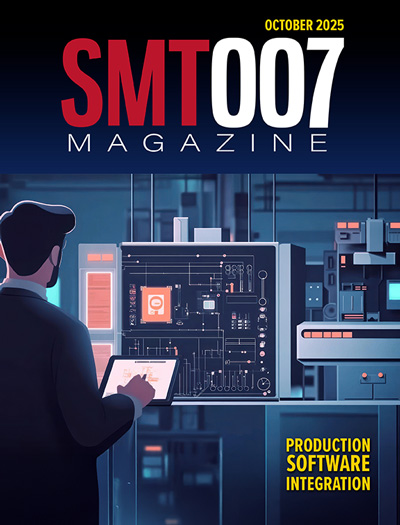-

- News
- Books
Featured Books
- smt007 Magazine
Latest Issues
Current Issue
Spotlight on Mexico
Mexico isn’t just part of the electronics manufacturing conversation—it’s leading it. From growing investments to cross-border collaborations, Mexico is fast becoming the center of electronics in North America. This issue includes bilingual content, with all feature articles available in both English and Spanish.

Production Software Integration
EMS companies need advanced software systems to thrive and compete. But these systems require significant effort to integrate and deploy. What is the reality, and how can we make it easier for everyone?

Spotlight on India
We invite you on a virtual tour of India’s thriving ecosystem, guided by the Global Electronics Association’s India office staff, who share their insights into the region’s growth and opportunities.
- Articles
Article Highlights
- Columns
- Links
- Media kit
||| MENU - smt007 Magazine
How CIM and IoT Can Make Your Factory Smart
October 12, 2018 | Zac Elliott, Mentor, A Siemens BusinessEstimated reading time: 7 minutes
With this delineation between the layers of applications in the smart factory, there is then a clear flow of data: business requirements flow down from the enterprise applications to the site applications. The site applications translate the requirements into concrete manufacturing plans, which flow down to the process applications. The process applications gather event data to send back up to the site applications. The site applications aggregate and summarize the relevant event data to be sent finally up to the enterprise applications.
Factory Intelligence Application
Depending on the point of view, there are many different, yet valid, perspectives on the performance of the factory. For instance, the fact the factory is on shutdown may be significant to a planner looking at overall factory capacity, but it is less significant to the production manager who simply wants to know if the machines are running efficiently when they are scheduled to run. With a mix of different customers, products, factories, lines, and machines, there may be hundreds of different KPIs to consider. Some of these measurements may be complex requiring data from multiple processes, for example overall equipment effectiveness (OEE) calculations, where we consider not only the performance of the factory resources but also the quality of the products being made.
With all this complexity, it is often the case that a bottleneck is caused by some external force that is not being measured. A machine may not be operating because of an actual malfunction in the equipment, or it may be waiting for some upstream or downstream process. Perhaps the operator is on break, or there is a shortage of materials causing the downtime. To identify the root cause of a problem and provide for an actionable response, these external forces must be considered.
A site-level factory intelligence application would need to consider information coming from the both the enterprise applications and the process applications. To begin, the process-specific applications would provide performance data regarding the status of the equipment being managed. Next, the site-based constraints will be used to qualify any process status based on constraints such as the overall factory schedule, material availability, or the upstream/downstream bottleneck.
With information about process performance and external the constraints influencing production, many optimization opportunities are possible. The process-specific layer can optimize based on external knowledge from other processes and higher-level applications, while the site application layer benefits from detailed process information from each individual equipment.
To read the full article, which appeared in the September 2018 issue of SMT007 Magazine, click here.
Page 2 of 2Testimonial
"The I-Connect007 team is outstanding—kind, responsive, and a true marketing partner. Their design team created fresh, eye-catching ads, and their editorial support polished our content to let our brand shine. Thank you all! "
Sweeney Ng - CEE PCBSuggested Items
SEL Receives Purdue Senior Design Partner of the Year Award
05/01/2025 | Schweitzer Engineering LaboratoriesSchweitzer Engineering Laboratories (SEL) has been awarded the Senior Design Partner of the Year Award from the Edwardson School of Industrial Engineering at Purdue University.
A Look Into the Future With Futurist Kevin Surace
04/07/2025 | Barry Matties, I-Connect007In this interview after his keynote address at IPC APEX EXPO 2025, futurist Kevin Surace reflects on important lessons learned and how they shaped his own future. He also makes some bold predictions for the use of AI in PCB board design, fabrication, and assembly—and what the common household will look like in 10 years. It’s an exciting and adventurous step into a future where humans work alongside robots, all for the betterment of everyone.
Networking and Growth: Highlights from the IPC Emerging Engineer Reception
03/19/2025 | Marcy LaRont, I-Connect007It was my first day in Anaheim for IPC APEX EXPO, and I arrived at John Wayne airport on Saturday to cool and sunny weather, which, coming from Arizona, is my favorite. The show starts with technical and standards work over the weekend as we prep for the show floor opening in the days to come. Exhibitors and union workers get busy building the impressive booths that make up the exhibition, which started on Tuesday and saw a steady flow of attendees all day long.
Mind Meld: Brian Chislea and AJ Arriaga Share Their Fascinating Experience in IPC's Mentorship Program
01/28/2025 | Michelle Te, IPC CommunityIPC’s Emerging Engineer program provides professionals an opportunity early in their careers to learn from dedicated industry volunteers participating in standards development. Two participants in the program—Brian Chislea, Dow Chemical, mentor to AJ Arriaga, Summit Interconnect—share their experiences in the program in a series of articles. We will follow them through their three years in the mentorship. This is the first in the series.
'Qualcomm AI Program for Innovators' Launched to Foster On-Device AI Innovation in the Asia-Pacific Region
12/27/2024 | Qualcomm Technologies, Inc.Qualcomm Technologies, Inc. announced the launch of the Qualcomm AI Program for Innovators (QAIPI) 2025 - APAC, a new initiative aimed at supporting professional developers and startups from Japan, Singapore, and South Korea to create cutting-edge on-device AI solutions across diverse sectors.


